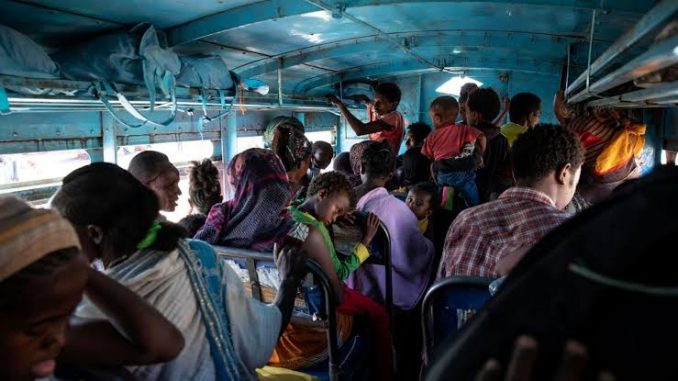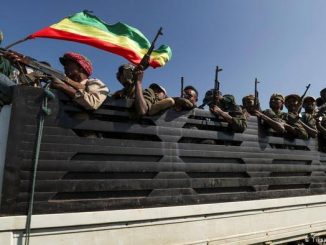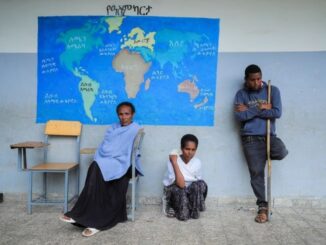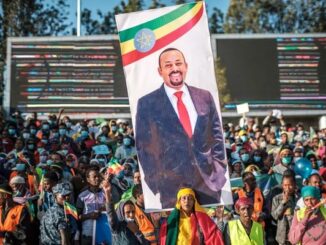
Recent human rights investigations confirm the atrocities that journalists reported in November. A strong multilateral push can force an Eritrean withdrawal and put the region on the path to peace, report Will Brown and Judd Devermont.
In November 2020, as war broke out in Ethiopia’s northern Tigray region, the scale of the suffering was already apparent to anyone on the Ethiopian-Sudanese border. As the Ethiopian National Defense Force and allied Amhara militias and Eritrean soldiers swept through the region in a pincer movement, Tigrayans began to flee en masse, walking for days without water to get to safety in neighboring Sudan.
Hundreds of refugees made an almost biblical sight as they traversed the Hamdayet River crossing that separates the two countries. Small boats laden with men, women, and children pushed against the current, ferrying people to safety every few minutes.
On the Sudanese side, middle-class Tigrayan women stood shaded under brightly colored umbrellas, desperately peering into every boat to look for their loved ones they had lost on the other side.
One woman’s anxiety was palpable. She had stood at the river in the beating sun with her baby strapped to her back for several days waiting for her family—and fearing the worst. “Please, help us,” she said. “Take their names and write about them.”
The refugees’ testimonies all pointed to indiscriminate artillery fire on civilian areas, massive looting, machete-wielding ethnic militiamen, and summary executions.
At one point, dozens of refugees fresh from the desert march and fearful of disclosing their identities started to shout out names of people they’d seen killed. One of us, reporting at the border, wrote down six names before the cacophony became overwhelming.
ALSO READ: Hundreds of civilians massacred in Axum during Tigray war, Amnesty says
Around 50,000 people from bordering Tigrayan towns made it into Sudan before the Ethiopian army began stationing men in federal army uniforms at intervals along the border, sealing it off.
Some refugees said they had been threatened with death if they kept going. “They threatened to cut our heads off if we kept trying to leave Tigray,” one mother of five said in late November.
Online trolls and officials in Ethiopia’s capital of Addis Ababa then launched a systematic campaign to discredit refugees’ accounts, claiming that agents of the Tigray People’s Liberation Front (TPLF) had infiltrated the Sudanese camps to spread disinformation about atrocities.
Over the last four months, Tigray’s continued communications blackout has made it incredibly difficult to confirm accusations of potential war crimes committed by forces on both sides. Amnesty International says Eritrean troops systematically killed hundreds of unarmed civilians in the northern city of Axum last November.
Yet information has slowly slipped out from behind the curtain. In December 2020, a news team from Belgium’s VRT News gained rare access to Tigray. They found medical centers ransacked for medication and saw patients, including a small girl, covered in debilitating infections from bullet and shrapnel wounds.
About two dozen photos—far too graphic to publish—sent to journalists by a resident of the regional capital Mekele who escaped Tigray show the bodies of children and adolescents blown to pieces by the government’s artillery barrage of the city.
The United Nations special advisor on the prevention of genocide, Alice Wairimu Nderitu, said she has received reports of extrajudicial killings, sexual violence, looting of property, mass executions, and impeded humanitarian access. Nderitu warned that without taking urgent measures, the risk of atrocity crimes “remains high and likely to get worse.”
In February, the Telegraph was sent four-minute-long video of fighters in Ethiopian federal army uniforms walking past dozens of dead men and boys. The clip is the first video evidence to emerge from Tigray, implicating the Ethiopian army in war crimes.
In the clip, which has been geolocated to a village on the outskirts of the 14th-century Debre Abbay monastery in central Tigray and verified as undoctored by the newspaper, soldiers taunt the few Tigrinya-speaking survivors in Ethiopia’s lingua franca, Amharic.
When one adolescent lying on the ground pleads with the soldiers in Tigrinya, one man shouts at him: “Keep talking, I’ll fuck your mother. Keep talking, you son of a bitch.”
With no action, the dire situation in Tigray will only get worse. Humanitarian agencies have been consistently blocked from working in the region and have issued dire statements saying that tens of thousands of people are now facing starvation. Refugees are reportedly turning up to aid centers emaciated. People are reportedly eating leaves to survive, drinking polluted water, and dying of hunger in their sleep.
ALSO READ: War crimes claims: UN, US demand Eritrean troops leave Ethiopia’s Tigray region
“There is an extreme urgent need—I don’t know what more words in English to use—to rapidly scale up the humanitarian response, because the population is dying every day as we speak,” Mari Carmen Vinoles, head of the emergency unit for Doctors Without Borders, told the Associated Press in January.
Aid workers have been consistently obstructed from providing emergency relief, however. Even the Ethiopian Red Cross, which has relatively good access compared to other organizations, said earlier this month that it could only reach 20 percent of the people in need in Tigray.
Hard questions need to be asked: Why is the blackout still largely in place, and why are so few aid workers being allowed in? Does Addis Ababa not want people looking into allegations of massive human rights abuses by federal troops? Or is it trying to hide the true extent to which Eritrea is involved in the conflict? Or maybe the federal government simply cannot allow access because it is not in control of vast stretches of the region? The Ethiopian government declined to reply to specific questions from Foreign Policy.
The conflict has a profound impact on Ethiopian public discourse, civil society, and social cohesion. For many non-Tigrayans, it has been a justifiable—even popular—military operation. There is very little love lost for the minority Tigrayans and their past domination of political and economic life in Ethiopia.
While the TPLF’s reign coincided with stunningly high rates of economic growth, the party and its coalition partners ruled with an iron fist. It arrested opposition leaders on trumped-up charges of corruption and erected an extensive network of citizen-spies, who, in a system known as “one to five,” were each responsible for keeping tabs on five other people.
Since the war erupted, triggered by a TPLF strike on the Ethiopian military’s northern command, there has been a deluge of misinformation from online accounts on both sides. In the melee, moderate voices have been squeezed from both sides. If an Ethiopian or international partner has pressed for peace and dialogue, the federal government has denounced them as Tigrayan sympathizers and enemies of the state.
When some have defended Ethiopian Prime Minister Abiy Ahmed’s response, they have been castigated as warmongers and accused of unwittingly doing Eritrea’s bidding. In this vortex of irreconcilable political differences, ethnic animosities, and regional rivalries, all sides have been accused of perpetrating atrocities.
Ethiopian journalists who dare to report details of the conflict that do not fit the government narrative have been subject to intimidation, hacking attempts, and death threats.
Reporters have been hit hard by the extraordinary outpouring of hatred. Ethiopian journalists who dare to report details of the conflict that do not fit the government narrative have been subject to intimidation, hacking attempts, and death threats.
In recent weeks, Ethiopia granted access to a select few outlets to cover Tigray. But almost immediately, translators and fixers for the Financial Times, Agence France-Presse, the New York Times, as well as the BBC’s Mekele reporter, were arrested. (They have since been released.)
Since the conflict began, several journalists have been arrested and one killed. In February, the freelance journalist Lucy Kassa’s house was raided by unknown attackers, most probably for reporting on allegations of mass rapes in Tigray.
Under the massive pressure, much of the Addis Ababa press corps has quietly moved whatever operations they can to Nairobi. “Tough times for us all … the fire and courage is not there anymore,” one journalist told us.
While Ethiopia’s federal forces are tied down in Tigray, other deep-seated problems are rearing their heads across the nation of 110 million people. Indeed, the civil war in Tigray is a symptom and only the most severe manifestation of Ethiopia’s troubles.
Abiy’s ascent and pledge to address long-standing grievances paradoxically reignited tensions between communities about identities, regional borders, and political representation. While the prior regime had locked communities into ethnically defined regions ruled by pliant leaders who only answered to federal authorities, Abiy promised to free Ethiopians from this rigid and repressive system. He permitted the Sidama zone to secede from the Southern Nations, Nationalities, and Peoples region, and stood by as communities formed militias and fought to redraw subnational borders.
His vision for a new Ethiopia, which he couldn’t deliver on fast enough, exposed him to withering critiques and turned adoring crowds into angry mobs. Abiy gradually revealed himself to be as intolerant of dissent as his predecessors, and he lashed out at his former allies-turned-rivals. Government forces surrounded the home of Oromo leader Jawar Mohammed and later arrested him.
A prominent protest singer, Hachalu Hundessa, was murdered over the summer, spurring public demonstrations. Before and since the outbreak of hostilities in Tigray, there have been pockets of violence across the country, including ethnic militias in Benishangul-Gumuz, friction on the Somali-Afar and Oromo-Somali borders, and rebel attacks in Oromia.
The country is rapidly unraveling under the stress of Abiy’s reforms and the strain of his rule. The current trajectory does not just promise more deaths and dislocations—it also imperils prospects for a free and fair election now scheduled for June 2021.
Abiy won plaudits from the Norwegian Nobel Committee and others for granting amnesty to political prisoners and legalizing outlawed parties, but he has been unwilling to extend the same olive branch to his opponents. Several parties, including the Oromo Federalist Congress from Abiy’s home region, have questioned whether they can participate in this year’s planned poll.
The conflict is as much a regional threat as it is a domestic one. The fighting in Tigray has engulfed the rest of the Horn of Africa. Abiy’s alliance with Eritrean leader Isaias Afwerki brought Eritrean troops into Tigray to bring the TPLF to heel. Isaias has harbored ill will toward the TPLF since the late 1990s when they fell out and fought a horrific border war, which was never fully resolved until Abiy’s rise to power. With Eritrea entering the fray, the TPLF fired rockets repeatedly into the neighboring country, in part to inflict some pain on Asmara and in part to rally Tigrayan support against a common enemy.
Ethiopia also has stumbled into a series of border skirmishes with another neighbor: Sudan. The two countries have long disputed their shared border in the Fashqa region, but they previously operated under a compromise of a “soft border.” Clashes first flared up late last year, and tensions have continued to escalate. On Feb. 14, the Sudanese government said Ethiopian forces crossed the border in an act of “aggression.”
U.S. Secretary of State Antony Blinken’s recent call with Abiy is a start, but so far, the international response has been tepid. While most governments have expressed alarm at developments, very few have truly stepped up to stop the unfolding tragedy. Only the European Union has suspended direct budgetary support—some $107 million—until humanitarian agencies are granted access.
While the United States and EU have urged Eritrea to withdraw its troops, the international community has failed to speak in one voice and has ignored some overarching challenges, including the threat to Ethiopia’s nascent democracy. The U.N. Security Council is finally set to discuss Ethiopia on March 11 following four months of relegating Ethiopia to “Any Other Business” rather than as a formal agenda item.
If the international community wants to prevent further atrocities and salvage Abiy’s initial vision of an inclusive Ethiopia, it should take the following steps.
First, there should be no wavering on the issue of delivering life-saving assistance. So far, the Ethiopian government has granted authorization for 84 international staff with 53 applications still pending as of late February. It has been too little too late, and it only applies to government-controlled areas.
The U.N. should insist that its humanitarian agencies be given unfettered access, including in areas controlled by the TPLF. It is indefensible that Ethiopian soldiers and the Amhara militias are blocking access, and that Eritrean and Ethiopian forces have targeted refugee camps filled with Eritreans.
The international community has to do more than sit on the sidelines regarding human rights violations and mass atrocities.
Second, the international community has to do more than sit on the sidelines regarding human rights violations and mass atrocities. Blinken in late February reiterated U.S. support for investigations into human rights violations and abuses, as well as full accountability. The U.N. should start issuing unilateral and multilateral sanctions, as well as consider additional steps to isolate Ethiopia and Eritrea if the governments are determined to be culpable.
Third, there is an urgent need to evict the Eritrean forces and deescalate the border tensions between Ethiopia and Sudan. The United States, which holds the Security Council presidency, plans to address conflict-induced starvation and hunger in Ethiopia in mid-March. It should similarly raise these pressing regional conflicts related to the Ethiopian crisis.
The African Union leadership, including the recently elected chairman, Congolese President Félix Tshisekedi, and incoming Political Affairs, Peace, and Security Commissioner Bankole Adeoye should do the same at the AU. This is also an opportunity to tap the Gulf States, which have influence with all three countries and have no interest in a regional conflagration near their doorstep.
Fourth, the prime minister should reopen a dialogue with the country’s regional administration, political parties, and disparate ethnic communities to recommit to an inclusive and tolerant Ethiopia. While the crisis in Tigray requires urgent attention, the root of the problem is considerably deeper and affects all of Ethiopia. A two-sided conversation between Abiy’s government and the TPLF is insufficient.
Fifth, it is imperative to link the aforementioned dialogue to the election process. The dispute between the federal government and Tigray intensified following the region’s decision to hold unilateral local elections. If the prime minister follows through with his plan to hold an election in June, the vote is unlikely to be credible or free and fair when there is fighting in Tigray, millions of people are displaced, and top opposition leaders are under arrest.
The international community should be wary of pressing for and funding an election without renewed support from key actors and access to the ballot box across the country.
Ethiopia’s descent into violence is a stain on the world’s conscience. The international community must not applaud Ethiopia for its promise and recoil when urgent action is required to prevent its implosion. This is Washington’s chance to show that the last four years of isolationism and callous indifference to conflicts abroad was an aberration. It will not be easy to salve what ails Ethiopia, but it will be catastrophic if global powers and regional leaders do not try.
—
• Will Brown is the Africa correspondent for the Telegraph. Twitter: @_Will_Brown




